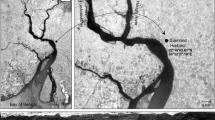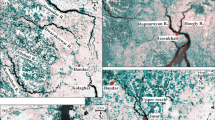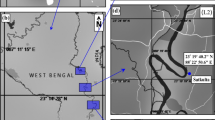Abstract
The action of wave dominated flow on river bank leads to retreatment of the bankline thereby causing intense erosion issues. The understanding of the bank erosion process mechanisms is of great importance in the context of protecting or controlling the progressive growth of bankline which imposes a direct threat on near bank fertile agricultural land and habitats. The present study emphasizes on acquiring improved understanding on the bank erosion processes related to wave action that severely impact the bank erosion rate. Turbulent fluctuations of the near bank flow were observed to be modulated due to the interplay between eroded bank wall and stream flow under the influence of wave following and against the current. The fluctuating turbulent velocity field was measured using micro acoustic Doppler velocimeter (ADV) at regions close to the bank wall during the different stages of the erosion progress. Streamwise turbulence intensity was found to be relatively large upto a particular undercut depth during the erosion progression. The integral time and length scales and Taylor microscales were determined for different temporal stages using autocorrelation function. Results depict that wave current combined flow in conjunction with rough wall surface formed by the erosion process amplifies the turbulent kinetic energy and turbulent dissipation rate at vicinity of the wall. The velocity fluctuations show large intermittency as evaluated from Gaussian pdf for wave current combined flows. This may affect the near wall turbulence structures which is a causative factor for enhancement of erosion rate as compared to current only flow.
Article highlights
-
Modulation of turbulence scales under wave current combined flow.
-
Interaction between wave current combined flow and roughness formed in bank wall due to erosion.
-
Turbulent structures and its effects on progressive bank erosion process.













Similar content being viewed by others
References
Clark LA, Wynn TM (2007) Methods for determining stream bank critical shear stress and soil erodibility: implications for erosion rate predictions. Trans ASABE 50(1):95–106. https://doi.org/10.13031/2013.22415
Jafarnejad M, Pfister M, Brühwiler E, Schleiss AJ (2017) Probabilistic failure analysis of riprap as riverbank protection under flood uncertainties. Stoch Environ Res Risk Assess 31(7):1839–1851. https://doi.org/10.1007/s00477-016-1368-6
Faraci C, Scandura P, Musumeci RE, Foti E (2018) Waves plus currents crossing at a right angle: near-bed velocity statistics. J Hydraul Res. https://doi.org/10.1080/00221686.2017.1397557
Buschman FA, Hoitink AJF, Van Der Vegt M, Hoekstra P (2009) Subtidal water level variation controlled by river flow and tides. Water Resour Res 45(10). https://doi.org/10.1029/2009WR008167
LeBlond PH (1979) Forced fortnightly tides in shallow rivers. Atmos-Ocean 17(3):253–264. https://doi.org/10.1080/07055900.1979.9649064
Godin G, Martínez A (1994) Numerical experiments to investigate the effects of quadratic friction on the propagation of tides in a channel. Cont Shelf Res 14(7–8):723–748. https://doi.org/10.1016/0278-4343(94)90070-1
Umeyama M (2009) Changes in turbulent flow structure under combined wave-current motions. J Waterw Port Coast Ocean Eng 135(5): 213–227. https://doi.org/10.1061/(ASCE)0733-950X(2009)
Grant WD, Madsen OS (1979) Combine wave and current interaction with rough bottom. J Geophys Res 84(4):1797–1808. https://doi.org/10.1029/JC084iC04p01797
Lodahl CR, Sumer BM, Fredsoe J (1998) Turbulent combined oscillatory Cow and current in a pipe. J Fluid Mech 373:313–348. https://doi.org/10.1017/S0022112098002559
Izadinia E, Heidarpour M, Schleiss AJ (2013) Investigation of turbulence flow and sediment entrainment around a bridge pier. Stoch Environ Res Risk Assess 27:1303–1314. https://doi.org/10.1007/s00477-012-0666-x
LeBlond PH (1978) On tidal propagation in shallow rivers. J Geophys Res: Oceans 83(C9):4717–4721. https://doi.org/10.1029/JC083iC09p04717
Hidayat H, Vermeulen B, Sassi MG, Torfs PJJF, Hoitink AJF (2011) Discharge estimation in a backwater affected meandering river. Hydrol Earth Syst Sci 15(8):2717–2728. https://doi.org/10.5194/hess-15-2717-2011
Faraci C, Foti E, Marini A, Scandura P (2012) Waves plus currents crossing at a right angle: sandpit case. J Waterway Port Coast Ocean Eng. https://doi.org/10.1061/(ASCE)WW.1943-5460.0000140
Faraci C, Musumeci RE, Marino M, Ruggeri A, Carlo L, Jensen B, Foti E, Barbaro G, Elsaßer B (2021) Wave- and currentdominated combined orthogonal flows over fixed rough beds. Cont Shelf Res. https://doi.org/10.1016/j.csr.2021.104403
Lim KY, Madsen OS (2016) An experimental study on near-orthogonal wave–current interaction over smooth and uniform fixed roughness beds. Coastal Eng. https://doi.org/10.1016/j.coastaleng.2016.05.005
Van Hoften JDA, Karaki S (1977) Interaction of waves and a turbulent current. Coast Eng 404–422. https://doi.org/10.1061/9780872620834.023
Kemp PH, Simons RR (1982) The interaction between waves and a turbulent current: waves propagating with the current. J Fluid Mech 116:227–250. https://doi.org/10.1017/S0022112082000445
Kemp PH, Simons RR (1983) The interaction of waves and a turbulent current: waves propagating against the current. J Fluid Mech 130:73–89. https://doi.org/10.1017/S0022112083000981
Umeyama M (2005) Reynolds stresses and velocity distributions in a wave–current coexisting environment. J Waterw Port Coast Ocean Eng 131(5): 203–212. https://doi.org/10.1061/(asce)0733-950x(2005)131:5(203)
Das VK, Roy S, Barman K, Chaudhuri S, Debnath K (2019) Study of clay–sand network structures and its effect on river bank erosion: An experimental approach. Environ Earth Sci 78(20):1–18. https://doi.org/10.1007/s12665-019-8613-5
Shojaeizadeh A, Safaei MR, Alrashed AA, Ghodsian M, Geza M, Abbassi MA (2018) Bed roughness effects on characteristics of turbulent confined wall jets. Measurement 122:325–338. https://doi.org/10.1016/j.measurement.2018.02.033
Krogstad PÅ, Antonia RA (1999) Surface roughness effects in turbulent boundary layers. Exp Fluids 27:450–460. https://doi.org/10.1007/s003480050370
Bhaganagar K, Kim J, Coleman G (2004) Effect of roughness on wall-bounded turbulence. Flow Turbul Combust 72(2–4):463–492. https://doi.org/10.1023/B:APPL.0000044407.34121.64
Corrsin S (1963) Estimates of the relations between Eulerian and Lagrangian scales in large Reynolds number turbulence. J Atmos Sci 20(2):115–119. https://doi.org/10.1175/1520-0469(1963)020%3c0115:EOTRBE%3e2.0.CO;2
Sreenivasan KR (1984) On the scaling of the turbulence energy dissipation rate. Phys Fluids 27:1048. https://doi.org/10.1063/1.864731
Antonia RA, Luxton RE (197l). The response of a turbulent boundarylaver to a step change in surface roughness. Part I. Smooth to rough. J Fluid Mech 48:721–761. https://doi.org/10.1017/S0022112071001824
Keylock CJ, Singh A, Foufoula-Georgiou E (2013) The influence of migrating bed forms on the velocity-intermittency structure of turbulent flow over a gravel bed. Geophys Res Lett 40(7):1351–1355. https://doi.org/10.1002/grl.50337
Frisch U (1995) Turbulence: the legacy of A. Cambridge University Press, Cambridge, N. Kolmogorov
Hopkinson LC, Walburn CZ (2016) Near-boundary velocity and turbulence in depth-varying stream flows. Environ Fluid Mech 16(3):559–574. https://doi.org/10.1007/s10652-015-9440-1
Azevedo R, Roja-Solórzano LR, Leal JB (2017) Turbulent structures, integral length scale and turbulent kinetic energy (TKE) dissipation rate in compound channel flow. Flow Meas Instrum 57:10–19. https://doi.org/10.1016/j.flowmeasinst.2017.08.009
Pope SB (2000) Turbulent flows. Cambridge University Press, Cambridge
Gole CV, Vaidyaraman PP (1966) Salinity distribution and effect of fresh water flows in the Hooghly River. Coast Eng 1412–1434
Das VK, Barman K, Roy S, Chaudhuri S, Debnath K (2020) Near bank turbulence of a river bend with self-similar morphological structures. CATENA 191:104582. https://doi.org/10.1016/j.catena.2020.104582
Kothyari UC, Jain RK (2008) InCuence of cohesion on incipient motion condition of sediment mixtures. Water Resour Res 44(4):1–15. https://doi.org/10.1029/2007WR006326
Jain RK, Kothyari UC (2009) Cohesion influences on erosion and bed load transport. Water Resour Res 45(6):1–17. https://doi.org/10.1029/2008WR007044
Debnath K, Chaudhuri S (2010) Laboratory experiments on local scour around cylinder for clay and clay–sand mixed beds. Eng Geol 111(1–4):51–61. https://doi.org/10.1016/j.enggeo.2009.12.003
Debnath K, Chaudhuri S (2012) Local scour around non-circular piers in clay–sand mixed cohesive sediment beds. Eng Geol 151:1–14. https://doi.org/10.1016/j.enggeo.2012.09.013
Das VK, Roy S, Barman K, Debnath K, Chaudhuri S, Mazumder BS (2019) Investigations on undercutting processes of cohesive river bank. Eng Geol 252:110–124. https://doi.org/10.1016/j.enggeo.2019.03.004
Mitchener H, Torfs H (1996) Erosion of mud/sand mixtures. Coast Eng 29:1–25. https://doi.org/10.1016/S0378-3839(96)00002-6
Ettema R, Melville BW, Barkdoll B (1998) Scale effect in pier-scour experiments. J Hydraul Eng 124(6):639–642. https://doi.org/10.1061/(ASCE)0733-9429(1998)124:6(639)
Ettema R, Kirkil G, Muste M (2006) Similitude of large-scale turbulence in experiments on local scour at cylinders. J Hydraul Eng 132(1):33–40. https://doi.org/10.1061/(ASCE)0733-9429(2006)132:1(33)
Lee SO, Sturm TW (2009) Effect of sediment size scaling on physical modeling of bridge pier scour. J Hydraul Eng 135(10):793–802. https://doi.org/10.1061/(ASCE)HY.1943-7900.0000091
Hjulstrom F (1935) Studies of the morphological activity of rivers as illustrated by the River Fyris, Bulletin. Geol Inst Upsalsa 25:221–527
Debnath K, Chaudhuri S (2011) Effect of suspended sediment concentration on local scour around cylinder for clay–sand mixed sediment beds. Eng Geol 117(3):236–245. https://doi.org/10.1016/j.enggeo.2010.11.003
Roy S, Debnath K, Mazumder BS (2018) Distribution of turbulent eddies behind a monopile for vortex lock-on condition due to wave current combined flow. Coast Eng 131:70–87. https://doi.org/10.1016/j.coastaleng.2017.10.010
García CM, Cantero MI, Niño Y, García MH (2005) Turbulence measurements with acoustic Doppler velocimeters. J Hydraul Eng 131(12):1062–1073. https://doi.org/10.1061/(ASCE)0733-9429(2005)131:12(1062)
Shinozuka M, Jan C (1972) Digital simulation of random processes and its applications. J Sound Vib 25(1):111–128. https://doi.org/10.1016/0022-460X(72)90600-1
Heskestad G (1965) A generalized Taylor hypothesis with application for high Reynolds number turbulent shear flows. J Appl Mech 32:735–739. https://doi.org/10.1115/1.3627310
Engel FL, Rhoads BL (2017) Velocity profiles and the structure of turbulence at the outer bank of a compound meander bend. Geomorphology 295:191–201. https://doi.org/10.1016/j.geomorph.2017.06.018
Goda Y (2000) Random seas and design of maritime structures. World Scientific Publishing Company, Singapore
Dean RG, Dalrymple RA (1991) Water wave mechanics for engineers and scientists. World Scientific Publishing Company, Singapore
Goring DG, Nikora VI (2002) Despiking acoustic Doppler velocimeter data. J Hydraul Eng 128(1):117–126. https://doi.org/10.1061/(ASCE)0733-9429(2002)128:1(117)
Schlicting H (1960) Boundary layer theory. McGraw Hill, New York
Guan D, Melville B, Friedrich H (2014) Flow patterns and turbulence structures in a scour hole downstream of a submerged weir. J Hydraul Eng 140(1):68–76. https://doi.org/10.1061/(ASCE)HY.1943-7900.0000803
Sanford L, Maa JPY (2001) A unified erosion formulation for fine sediments. Mar Geol 1791(2):9–23. https://doi.org/10.1016/S0025-3227(01)00201-8
Amos CL, Daborn GR, Christian HA, Atkinson A, Robertson A (1992) In situ erosion measurements on fine-grained sediments from the Bay of Fundy. Mar Geol 1082:175–196. https://doi.org/10.1016/0025-3227(92)90171-D
Das VK, Roy S, Barman K, Chaudhuri S, Debnath K (2020) Cohesive River bank erosion mechanism under wave-current interaction: a flume study. J Earth Sys Sci 129(1):1–20. https://doi.org/10.1007/s12040-020-1363-7
Das VK, Hansda S, Debnath K, Chaudhuri S, Mazumder BS (2020b) Assessing the hydraulic performance of bamboo logs in riverbank stabilization: case study of Sundarbans, India. Hydrolog Sci J 1–18. https://doi.org/10.1080/02626667.2020.1851692
Hansda S, Barman K, Roy S, Debnath K (2019) Quantification of turbulent eddies in time-space and frequency domain for wave-current combined flow over side-wall roughness. Ocean Eng 186:106080. https://doi.org/10.1016/j.oceaneng.2019.05.062
Mazurek KA, Rajaratnam N, Sego DC (2001) Scour of cohesive soil by submerged circular turbulent impinging jets. J Hydraul Eng 127:598–606
Esfahani FS, Keshavarzi A (2013) Dynamic mechanism of turbulent flow in meandering channels: considerations for deflection angle. Stoch Environ Res Risk Assess 27(5):1093–1114. https://doi.org/10.1007/s00477-012-0647-0
Kean JW, Smith JD (2006) Form drag in rivers due to small scale natural topographic features: 2. Irregular sequences. J Geophys Res Earth Surf 111(F4). https://doi.org/10.1029/2006JF000490
Sleath JFA (1987) Turbulent oscillatory flow over rough beds. J Fluid Mech 182:369–409. https://doi.org/10.1017/S0022112087002374
McCaffrey K, Fox-Kemper B, Hamlington PE, Thomson J (2015) Characterization of turbulence anisotropy, coherence, and intermittency at a prospective tidal energy site: Observational data analysis. Renew Energy 76:441–453. https://doi.org/10.1016/j.renene.2014.11.063
Novo PG, Kyozuka Y (2016) Field measurement and numerical study of tidal current turbulence intensity in the Kobe Strait of the Goto Islands. Nagasaki Prefecture J Mar Sci Technol 22(2):335–350. https://doi.org/10.1007/s00773-016-0414-x
Imamura J, Takagi K, Nagaya S (2019) Engineering analysis of turbulent flow measurements near Kuchinoshima Island. J Mar Sci Technol 24(2):329–337. https://doi.org/10.1007/s00773-018-0573-z
Krogstad PÅ, Antonia RA (1994) Structure of turbulent boundary layers on smooth and rough walls. J Fluid Mech 277:1–21. https://doi.org/10.1017/S0022112094002661
Das VK, Hansda S, Debnath K, Chaudhuri S (2021) Riverbank stabilization based on the modulation of the near bank turbulence scales. Environ Dev Sustain 1–24. https://doi.org/10.1007/s10668-021-01298-z
Venditti JG, Church MA, Bennett SJ (2005) Bed form initiation from a flat sand bed. J Geophys Res Earth Surf 110(F1). https://doi.org/10.1029/2004JF000149
Tennekes H, Lumley JL (1972) A first course in turbulence. MIT Press
Heydari N, Diplas P (2020) Flow dynamics in the vicinity of a gravel embedded vertical retaining wall: conditions corresponding to the initial stages of local erosion. Environ Fluid Mech 20(1):203–225. https://doi.org/10.1007/s10652-019-09715-8
Roy S, Das VK, Debnath K (2019) Characteristics of intermittent turbulent structures for river bank undercut depth increment. CATENA 172:356–368. https://doi.org/10.1016/j.catena.2018.09.008
Petti M, Longo S (2001) Turbulence experiments in the swash zone. Coast Eng 43(1):1–24. https://doi.org/10.1016/S0378-3839(00)00068-5
Bewley GP, Chang K, Bodenschatz E (2012) On integral length scales in anisotropic turbulence. Phys Fluids 24(6):061702. https://doi.org/10.1063/1.4726077
Nezu I, Nakagawa H (1993) Turbulence in open-channel flows. IAHR Monogr Ser
Falcon E, Fauve S, Laroche C (2007) Observation of intermittency in wave turbulence. Phys Rev Lett 98(15):154501. https://doi.org/10.1103/PhysRevLett.98.154501
Böttcher F, Peinke J (2007) Small and large scale fluctuations in atmospheric wind speeds. Stoch Environ Res Risk Assess 21(3):299–308. https://doi.org/10.1007/s00477-006-0065-2
Coscarella F, Penna N, Servidio S, Gaudio R (2020) Turbulence anisotropy and intermittency in open-channel flows on rough beds. Phys Fluids 32(11):115127. https://doi.org/10.1063/5.0028119
Pouquet A (2018) Intermittent turbulence in a global ocean model. Physics 11:21. https://physics.aps.org/articles/v11/21
Jiménez J (2007) Intermittency in turbulence. In: Proceedings of 15th “Aha Huliko” a winter workshop, extreme events, pp 81–90
She ZS, Leveque E (1994) Universal scaling laws in fully developed turbulence. Phys Rev Lett 72(3):336. https://doi.org/10.1103/PhysRevLett.72.336
Cheng YS (2002) Exponential formula for bedload transport. J Hydraul Eng ASCE 128(10):942–946. https://doi.org/10.1061/(ASCE)0733-9429(2002)128:10(942)
Yang SY (2005) Formula for sediment transport in rivers, estuaries, and coastal waters. J Hydraul Eng ASCE 131(11):968–979. https://doi.org/10.1061/(ASCE)0733-9429(2005)131:11(968)
Acknowledgements
The authors would like to acknowledge the Science & Engineering Research Board, Department of Science and Technology, Government of India for the financial support for this research (Contract No. EMR/2015/000266).
Funding
This work was supported by Department of Science and Technology, Government of India (Contract No. EMR/2015/000266).
Author information
Authors and Affiliations
Corresponding author
Ethics declarations
Conflict of interest
The authors declare that they have no known competing financial interests or personal relationships that could have appeared to influence the work reported in this paper. The authors declare the following financial interests/personal relationships which may be considered as potential competing interests.
Additional information
Publisher's Note
Springer Nature remains neutral with regard to jurisdictional claims in published maps and institutional affiliations.
Rights and permissions
About this article
Cite this article
Hansda, S., Das, V.K. & Debnath, K. Temporal modulation of turbulence structure over progressive erosion boundary under influence of wave current combined flow. Environ Fluid Mech 22, 683–713 (2022). https://doi.org/10.1007/s10652-022-09846-5
Received:
Accepted:
Published:
Issue Date:
DOI: https://doi.org/10.1007/s10652-022-09846-5




